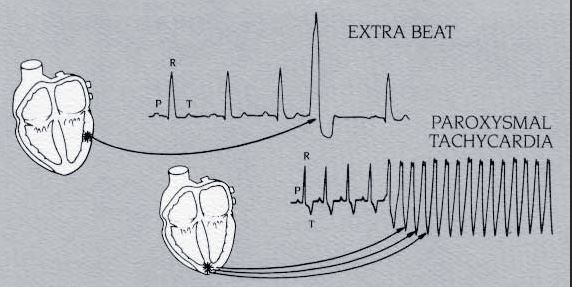WHAT IS AN ELECTROCARDIOGRAM?
An electrocardiogram (ECG) is a test used widely to assess the condition of the heart. The ECG is used to evaluate the status of the heart’s conduction system. the status of the muscle. and indirectly, the condition of the heart as a pump. The ECG is a graphical presentation of the electrical activity (voltage) of the heart muscle and an ECG machine (electrocardiograph) is a recording voltmeter. The series of wavy lines represents the recording of the ECG machine that ”reads” heartbeats and prints them out on a special pressure sensitive paper. These readings are the veterinarian’s tool for diagnosing cardiac abnormalities. The heart beats because a wave of electrical energy moves through the tissues of the chambers. starting in the atria and moving down to the ventricles. This electrical wave makes the muscle wall of these chambers contract, pumping out its contained blood
 THE NORMAL ELECTROCARDIOGRAM A spot of specialized tissue in the heart called the sinoatrial node sends out a short burst of electrical energy that follows the electrical conduction path of the heart. The small round wave ”P” originates in the atria while the large spike “R” originates in the ventricles. The P wave is caused by the depolarization and subsequent contraction of the atria. The R wave (called QRS complex) is the depolarization of the ventricles. The T wave is the repolarization of the ventricles after which the heart muscle is ready for the next pulse from the sinoatrial node. If the heart beats 120 times per minute, there normally should occur 120 P-QRS-T complexes. Irregularities in the shape (morphology) of the P-QRS-T complex indicate heart muscle abnormalities.
THE NORMAL ELECTROCARDIOGRAM A spot of specialized tissue in the heart called the sinoatrial node sends out a short burst of electrical energy that follows the electrical conduction path of the heart. The small round wave ”P” originates in the atria while the large spike “R” originates in the ventricles. The P wave is caused by the depolarization and subsequent contraction of the atria. The R wave (called QRS complex) is the depolarization of the ventricles. The T wave is the repolarization of the ventricles after which the heart muscle is ready for the next pulse from the sinoatrial node. If the heart beats 120 times per minute, there normally should occur 120 P-QRS-T complexes. Irregularities in the shape (morphology) of the P-QRS-T complex indicate heart muscle abnormalities.
 THE ABNORMAL ELECTROCARDIOGRAM Irregularities in the timing of the wave forms (rhythm) either within one complex or between several complexes indicate abnormalities. Normal variations and medically important ECG conditions make the practice of diagnostic ECG interpretation a complex and hard learned profession. A common change in rhythm is premature beat, or extra beat. The extra, or ectopic beat comes soon after the normal beat like this: Beat Beat Beatbeat Beat. Many things can cause the cardiac tissue to become irritable: excitement, drugs, trauma, and many times heart disease. If these extra beats come often then serious signs of heart disease can take place. Paroxysmal tachycardia can then be the result. Without any warning the heart suddenly begins to race: Beat Beat Beatbeatbeatbeatbeatbeat and so on for an indefinite period. This abnormality in rhythm can eventually cause the heart to fail and cause an inadequate blood flow. Your veterinarian’s instructions should be followed as medication can be effective.
THE ABNORMAL ELECTROCARDIOGRAM Irregularities in the timing of the wave forms (rhythm) either within one complex or between several complexes indicate abnormalities. Normal variations and medically important ECG conditions make the practice of diagnostic ECG interpretation a complex and hard learned profession. A common change in rhythm is premature beat, or extra beat. The extra, or ectopic beat comes soon after the normal beat like this: Beat Beat Beatbeat Beat. Many things can cause the cardiac tissue to become irritable: excitement, drugs, trauma, and many times heart disease. If these extra beats come often then serious signs of heart disease can take place. Paroxysmal tachycardia can then be the result. Without any warning the heart suddenly begins to race: Beat Beat Beatbeatbeatbeatbeatbeat and so on for an indefinite period. This abnormality in rhythm can eventually cause the heart to fail and cause an inadequate blood flow. Your veterinarian’s instructions should be followed as medication can be effective.
From Tilley, L.P.: Essentials of Canine & Feline Electrocardiography, 2 Ed. Lea E, Febiger, Philadelphia, 1985. (Adapted from “What is an electrocardiogram?” Hewlett-Packard, J Oct. 1981.1